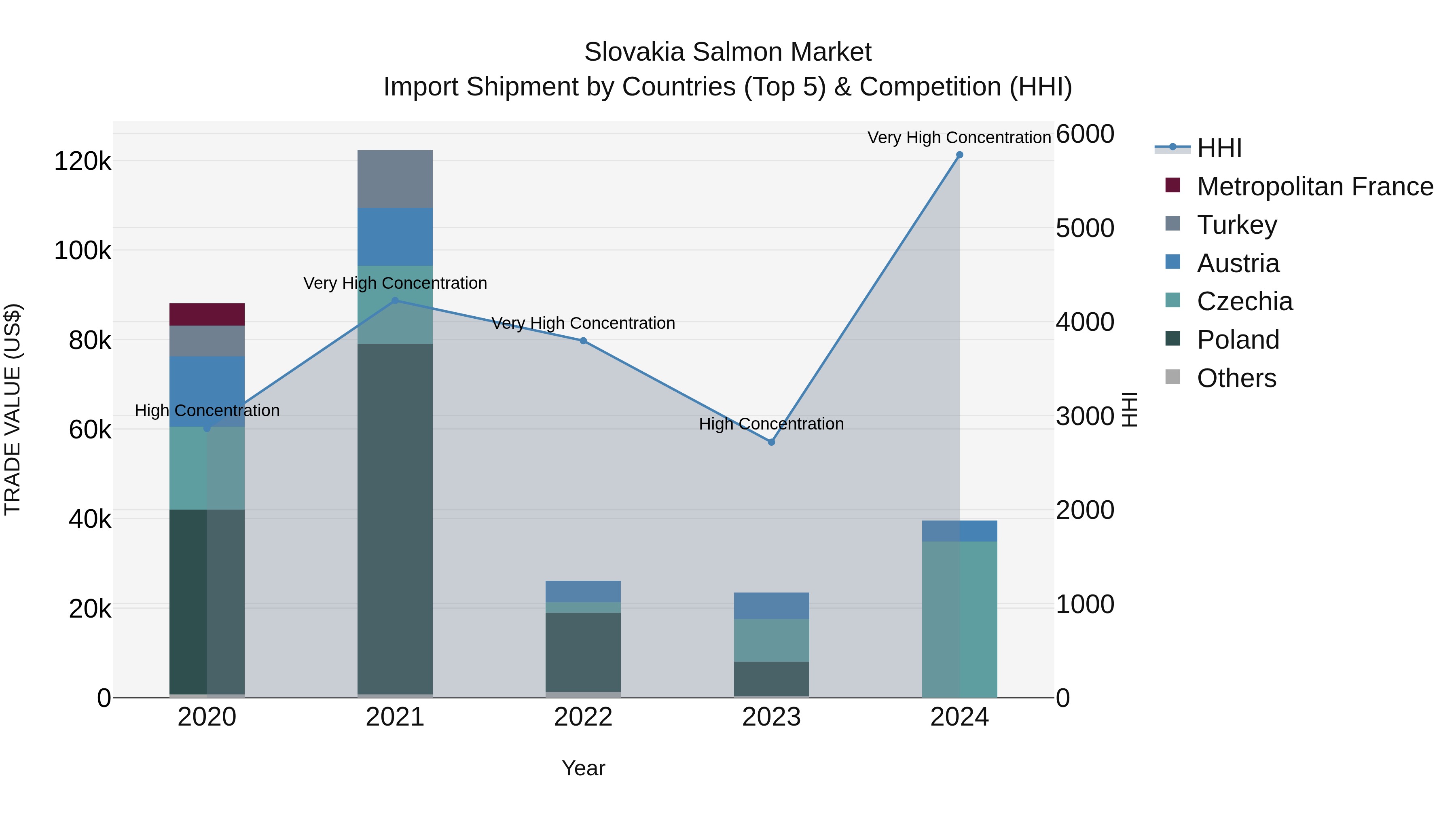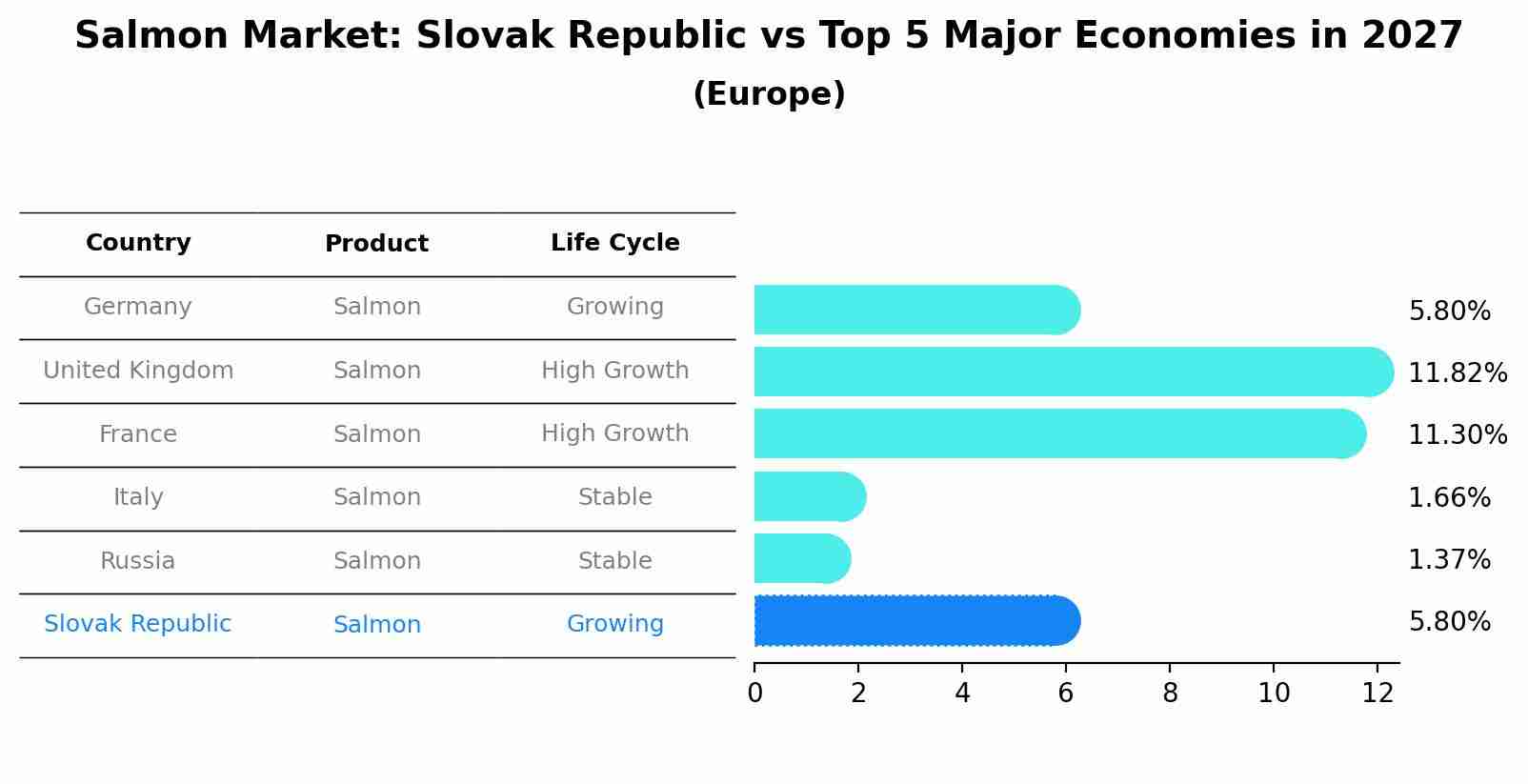Slovakia Salmon Market (2025-2031) Outlook | Industry, Forecast, Revenue, Trends, Size, Growth, Companies, Value, Analysis & Share
| Product Code: ETC387620 | Publication Date: Aug 2022 | Updated Date: Nov 2025 | Product Type: Market Research Report | |
| Publisher: 6Wresearch | Author: Sumit Sagar | No. of Pages: 75 | No. of Figures: 35 | No. of Tables: 20 |
Slovakia Salmon Market Top 5 Importing Countries and Market Competition (HHI) Analysis
Despite a high concentration of imports from top countries like Czechia, Austria, and Denmark, Slovakia experienced a significant decline in salmon import shipments with a negative CAGR of -18.14% from 2020 to 2024. However, there was a notable rebound in 2024 with a growth rate of 68.18% compared to the previous year. This fluctuation indicates potential shifts in Market Top 5 Importing Countries and Market Competition (HHI) Analysis dynamics and consumer demand for salmon in Slovakia. It will be crucial for stakeholders to closely monitor these trends to adapt their strategies accordingly.

Salmon Market: Slovak Republic vs Top 5 Major Economies in 2027 (Europe)
Slovak Republic's Salmon market is anticipated to experience a growing growth rate of 5.80% by 2027, reflecting trends observed in the largest economy Germany, followed by United Kingdom, France, Italy and Russia.

Slovakia Salmon Market Synopsis
The Slovakia salmon market is a niche but growing segment within the country`s seafood industry. Despite being a landlocked country, Slovakia imports salmon primarily from Norway, Scotland, and other European countries to meet the increasing demand for this popular fish among consumers. Salmon is widely available in supermarkets, fish markets, and restaurants across Slovakia, catering to both domestic consumption and the hospitality sector. The market is driven by factors such as the rising health consciousness among consumers, increasing disposable income, and the growing popularity of seafood in the Slovakian diet. Additionally, the presence of various distribution channels and the influence of global food trends contribute to the steady growth and diversification of the Slovakia salmon market.
Slovakia Salmon Market Trends
The Slovakia salmon market is witnessing a growing demand for high-quality, sustainably sourced salmon products. Consumers are increasingly seeking out salmon products that are certified as organic, eco-friendly, and free from additives or preservatives. There is a notable trend towards smoked and ready-to-eat salmon products, catering to the busy lifestyles of modern consumers. Additionally, there is a rising interest in salmon-based dishes in restaurants and home cooking, driving the demand for fresh salmon fillets and portions. With a focus on health and wellness, consumers are also looking for salmon products that are rich in omega-3 fatty acids and offer various health benefits. Overall, the Slovakia salmon market is evolving to meet the preferences of discerning consumers who prioritize quality, sustainability, and convenience in their seafood choices.
Slovakia Salmon Market Challenges
In the Slovakia Salmon Market, one of the main challenges faced is the relatively low consumption of salmon compared to other types of fish, such as carp or trout, which are more traditional in Slovak cuisine. This poses a hurdle for salmon producers and distributors in terms of market penetration and increasing demand. Additionally, the landlocked geography of Slovakia presents logistical challenges in terms of importing fresh salmon, leading to higher transportation costs and potential delays in delivery. Furthermore, consumer awareness and education about the health benefits and versatility of salmon compared to other fish varieties is needed to drive demand and overcome cultural preferences. Overall, increasing consumption, addressing logistical issues, and educating consumers are key challenges that need to be addressed in the Slovakia Salmon Market.
Slovakia Salmon Market Investment Opportunities
In the Slovakia Salmon Market, there are several investment opportunities available for potential investors. One area of interest is the growth potential in salmon farming operations in the country, as Slovakia has a growing demand for high-quality seafood products. Investing in aquaculture companies that focus on sustainable and innovative salmon farming practices could be profitable. Additionally, there is an opportunity to invest in distribution and retail channels to meet the increasing consumer demand for salmon products in Slovakia. Collaborating with local suppliers and retailers to ensure a steady supply chain of salmon can also be a promising investment avenue. Overall, the Slovakia Salmon Market presents opportunities for investors looking to capitalize on the growing popularity of salmon consumption in the country.
Jordan Agar Market Government Policies
The Slovakian government has implemented policies to regulate the salmon market, focusing on environmental sustainability and consumer protection. These policies include strict regulations on aquaculture practices to ensure the health and safety of the salmon produced in the country. The government also enforces labeling requirements to provide consumers with accurate information about the origin and quality of the salmon they purchase. Additionally, there are measures in place to prevent overfishing and protect wild salmon populations in Slovakian waters. Overall, the government`s policies aim to promote a sustainable and transparent salmon market that prioritizes environmental conservation and consumer confidence.
Slovakia Salmon Market Future Outlook
The future outlook for the Slovakia Salmon Market is promising, with a projected growth in demand driven by increasing consumer awareness of the health benefits associated with salmon consumption. The market is expected to witness a steady rise in both domestic consumption and export opportunities, supported by the country`s growing economy and changing dietary preferences towards healthier food choices. Additionally, advancements in aquaculture technology and sustainable fishing practices are likely to enhance the availability of high-quality salmon products in the market. However, challenges such as price volatility, competition from other protein sources, and environmental concerns regarding salmon farming practices may impact the market`s growth trajectory. Overall, the Slovakia Salmon Market is poised for expansion, with opportunities for market players to capitalize on the growing demand for premium seafood products.
Key Highlights of the Report:
- Slovakia Salmon Market Outlook
- Market Size of Slovakia Salmon Market, 2024
- Forecast of Slovakia Salmon Market, 2031
- Historical Data and Forecast of Slovakia Salmon Revenues & Volume for the Period 2021 - 2031
- Slovakia Salmon Market Trend Evolution
- Slovakia Salmon Market Drivers and Challenges
- Slovakia Salmon Price Trends
- Slovakia Salmon Porter's Five Forces
- Slovakia Salmon Industry Life Cycle
- Historical Data and Forecast of Slovakia Salmon Market Revenues & Volume By Type for the Period 2021 - 2031
- Historical Data and Forecast of Slovakia Salmon Market Revenues & Volume By Chinook Salmon for the Period 2021 - 2031
- Historical Data and Forecast of Slovakia Salmon Market Revenues & Volume By Coho Salmon for the Period 2021 - 2031
- Historical Data and Forecast of Slovakia Salmon Market Revenues & Volume By Pink Salmon for the Period 2021 - 2031
- Historical Data and Forecast of Slovakia Salmon Market Revenues & Volume By Red Salmon for the Period 2021 - 2031
- Historical Data and Forecast of Slovakia Salmon Market Revenues & Volume By Salmo Salar for the Period 2021 - 2031
- Historical Data and Forecast of Slovakia Salmon Market Revenues & Volume By Silverbrite Salmon for the Period 2021 - 2031
- Historical Data and Forecast of Slovakia Salmon Market Revenues & Volume By End Product Type for the Period 2021 - 2031
- Historical Data and Forecast of Slovakia Salmon Market Revenues & Volume By Fresh for the Period 2021 - 2031
- Historical Data and Forecast of Slovakia Salmon Market Revenues & Volume By Frozen for the Period 2021 - 2031
- Historical Data and Forecast of Slovakia Salmon Market Revenues & Volume By Canned for the Period 2021 - 2031
- Historical Data and Forecast of Slovakia Salmon Market Revenues & Volume By Others for the Period 2021 - 2031
- Historical Data and Forecast of Slovakia Salmon Market Revenues & Volume By Distribution Channel for the Period 2021 - 2031
- Historical Data and Forecast of Slovakia Salmon Market Revenues & Volume By Retail Stores for the Period 2021 - 2031
- Historical Data and Forecast of Slovakia Salmon Market Revenues & Volume By Hypermarket/supermarket for the Period 2021 - 2031
- Historical Data and Forecast of Slovakia Salmon Market Revenues & Volume By Online Sales Channels for the Period 2021 - 2031
- Slovakia Salmon Import Export Trade Statistics
- Market Opportunity Assessment By Type
- Market Opportunity Assessment By End Product Type
- Market Opportunity Assessment By Distribution Channel
- Slovakia Salmon Top Companies Market Share
- Slovakia Salmon Competitive Benchmarking By Technical and Operational Parameters
- Slovakia Salmon Company Profiles
- Slovakia Salmon Key Strategic Recommendations
Frequently Asked Questions About the Market Study (FAQs):
- Single User License$ 1,995
- Department License$ 2,400
- Site License$ 3,120
- Global License$ 3,795
Search
Thought Leadership and Analyst Meet
Our Clients
Related Reports
- Afghanistan Apparel Market (2026-2032) | Growth, Outlook, Industry, Segmentation, Forecast, Size, Companies, Trends, Value, Share, Analysis & Revenue
- Canada Oil and Gas Market (2026-2032) | Share, Segmentation, Value, Industry, Trends, Forecast, Analysis, Size & Revenue, Growth, Competitive Landscape, Outlook, Companies
- Germany Breakfast Food Market (2026-2032) | Industry, Share, Growth, Size, Companies, Value, Analysis, Revenue, Trends, Forecast & Outlook
- Australia Briquette Market (2025-2031) | Growth, Size, Revenue, Forecast, Analysis, Trends, Value, Share, Industry & Companies
- Vietnam System Integrator Market (2025-2031) | Size, Companies, Analysis, Industry, Value, Forecast, Growth, Trends, Revenue & Share
- ASEAN and Thailand Brain Health Supplements Market (2025-2031) | Strategy, Consumer Insights, Analysis, Investment Trends, Opportunities, Growth, Size, Share, Industry, Revenue, Segments, Value, Segmentation, Supply, Forecast, Restraints, Outlook, Competition, Drivers, Trends, Demand, Pricing Analysis, Competitive, Strategic Insights, Companies, Challenges
- ASEAN Bearings Market (2025-2031) | Strategy, Consumer Insights, Analysis, Investment Trends, Opportunities, Growth, Size, Share, Industry, Revenue, Segments, Value, Segmentation, Supply, Forecast, Restraints, Outlook, Competition, Drivers, Trends, Demand, Pricing Analysis, Competitive, Strategic Insights, Companies, Challenges
- Europe Flooring Market (2025-2031) | Outlook, Share, Industry, Trends, Forecast, Companies, Revenue, Size, Analysis, Growth & Value
- Saudi Arabia Manlift Market (2025-2031) | Outlook, Size, Growth, Trends, Companies, Industry, Revenue, Value, Share, Forecast & Analysis
- Uganda Excavator, Crane, and Wheel Loaders Market (2025-2031) | Strategy, Consumer Insights, Analysis, Investment Trends, Opportunities, Growth, Size, Share, Industry, Revenue, Segments, Value, Segmentation, Supply, Forecast, Restraints, Outlook, Competition, Drivers, Trends, Demand, Pricing Analysis, Competitive, Strategic Insights, Companies, Challenges
Industry Events and Analyst Meet
Whitepaper
- Middle East & Africa Commercial Security Market Click here to view more.
- Middle East & Africa Fire Safety Systems & Equipment Market Click here to view more.
- GCC Drone Market Click here to view more.
- Middle East Lighting Fixture Market Click here to view more.
- GCC Physical & Perimeter Security Market Click here to view more.
6WResearch In News
- Doha a strategic location for EV manufacturing hub: IPA Qatar
- Demand for luxury TVs surging in the GCC, says Samsung
- Empowering Growth: The Thriving Journey of Bangladesh’s Cable Industry
- Demand for luxury TVs surging in the GCC, says Samsung
- Video call with a traditional healer? Once unthinkable, it’s now common in South Africa
- Intelligent Buildings To Smooth GCC’s Path To Net Zero


















